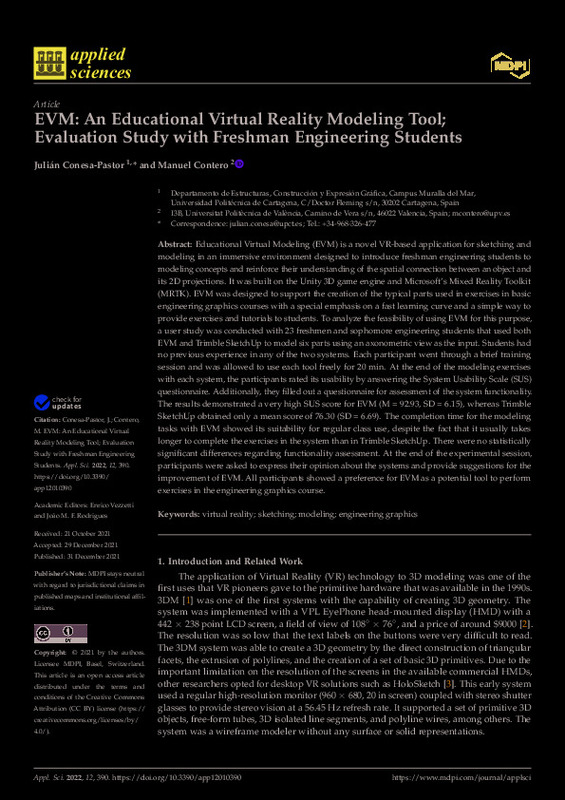JavaScript is disabled for your browser. Some features of this site may not work without it.
Buscar en RiuNet
Listar
Mi cuenta
Estadísticas
Ayuda RiuNet
Admin. UPV
EVM: An Educational Virtual Reality Modeling Tool; Evaluation Study with Freshman Engineering Students
Mostrar el registro sencillo del ítem
Ficheros en el ítem
| dc.contributor.author | Conesa-Pastor, Julián
|
es_ES |
| dc.contributor.author | Contero, Manuel
|
es_ES |
| dc.date.accessioned | 2023-05-22T18:02:22Z | |
| dc.date.available | 2023-05-22T18:02:22Z | |
| dc.date.issued | 2022-01 | es_ES |
| dc.identifier.uri | http://hdl.handle.net/10251/193508 | |
| dc.description.abstract | [EN] Educational Virtual Modeling (EVM) is a novel VR-based application for sketching and modeling in an immersive environment designed to introduce freshman engineering students to modeling concepts and reinforce their understanding of the spatial connection between an object and its 2D projections. It was built on the Unity 3D game engine and Microsoft's Mixed Reality Toolkit (MRTK). EVM was designed to support the creation of the typical parts used in exercises in basic engineering graphics courses with a special emphasis on a fast learning curve and a simple way to provide exercises and tutorials to students. To analyze the feasibility of using EVM for this purpose, a user study was conducted with 23 freshmen and sophomore engineering students that used both EVM and Trimble SketchUp to model six parts using an axonometric view as the input. Students had no previous experience in any of the two systems. Each participant went through a brief training session and was allowed to use each tool freely for 20 min. At the end of the modeling exercises with each system, the participants rated its usability by answering the System Usability Scale (SUS) questionnaire. Additionally, they filled out a questionnaire for assessment of the system functionality. The results demonstrated a very high SUS score for EVM (M = 92.93, SD = 6.15), whereas Trimble SketchUp obtained only a mean score of 76.30 (SD = 6.69). The completion time for the modeling tasks with EVM showed its suitability for regular class use, despite the fact that it usually takes longer to complete the exercises in the system than in Trimble SketchUp. There were no statistically significant differences regarding functionality assessment. At the end of the experimental session, participants were asked to express their opinion about the systems and provide suggestions for the improvement of EVM. All participants showed a preference for EVM as a potential tool to perform exercises in the engineering graphics course. | es_ES |
| dc.language | Inglés | es_ES |
| dc.publisher | MDPI AG | es_ES |
| dc.relation.ispartof | Applied Sciences | es_ES |
| dc.rights | Reconocimiento (by) | es_ES |
| dc.subject | Virtual reality | es_ES |
| dc.subject | Sketching | es_ES |
| dc.subject | Modeling | es_ES |
| dc.subject | Engineering graphics | es_ES |
| dc.subject.classification | EXPRESION GRAFICA EN LA INGENIERIA | es_ES |
| dc.title | EVM: An Educational Virtual Reality Modeling Tool; Evaluation Study with Freshman Engineering Students | es_ES |
| dc.type | Artículo | es_ES |
| dc.identifier.doi | 10.3390/app12010390 | es_ES |
| dc.rights.accessRights | Abierto | es_ES |
| dc.contributor.affiliation | Universitat Politècnica de València. Escuela Técnica Superior de Ingenieros Industriales - Escola Tècnica Superior d'Enginyers Industrials | es_ES |
| dc.description.bibliographicCitation | Conesa-Pastor, J.; Contero, M. (2022). EVM: An Educational Virtual Reality Modeling Tool; Evaluation Study with Freshman Engineering Students. Applied Sciences. 12(1):1-16. https://doi.org/10.3390/app12010390 | es_ES |
| dc.description.accrualMethod | S | es_ES |
| dc.relation.publisherversion | https://doi.org/10.3390/app12010390 | es_ES |
| dc.description.upvformatpinicio | 1 | es_ES |
| dc.description.upvformatpfin | 16 | es_ES |
| dc.type.version | info:eu-repo/semantics/publishedVersion | es_ES |
| dc.description.volume | 12 | es_ES |
| dc.description.issue | 1 | es_ES |
| dc.identifier.eissn | 2076-3417 | es_ES |
| dc.relation.pasarela | S\488943 | es_ES |








